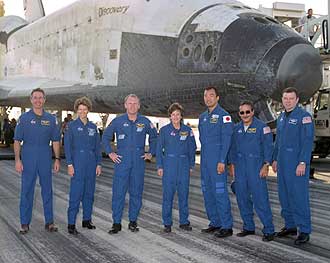'I'm from Iowa. I just work in outer space.' - Captain Kirk.
With fingers crossed, I sat glued to the TV yesterday watching the landing of the space shuttle Discovery at Edwards Air Force Base in California. Thankfully, the orbiter itself glided down smoothly onto the runway without a hitch, bringing its seven-member crew safely back to Earth.
Despite the fanfares from NASA about the 'success' of the mission, it hasn't been an easy ride for those seven astronauts.
First off, they had to contend with a similar problem on lift-off that doomed the Columbia years ago - a big chunk of insulating foam fell from the fuel tank narrowly missing the spacecraft itself. And then, while in space, they were called upon to remove protruding tile fillers from the heat shield on the underside of the craft.
So when the giant spacecraft finally landed, I was relieved that the brave folks inside the beast had made it back at all.

The crew proudly stands in front of Discovery at Edwards Air Force Base. Credit: NASA.
The failure of the engineers at NASA to improve upon the performance of the shuttle fuel tank over the past few years and the sight of astronauts in space patching up their ship is more than just a little concerning. It makes you wonder what they've all been doing since the Columbia disaster, doesn't it? Thankfully, the shuttle won't be going anywhere for a while until they've conducted a thorough investigation into the current problems. And hopefully, it will be a more thorough investigation than the last thorough investigation.
In the meantime, the whole thorny subject of manned space travel has been called into question once again. There are some that believe that given the risks to human life, we'd be better off simply sending robots into space instead.
But they're missing the point. The only reason that there is a risk to life at all is the poor design of the shuttle itself. If NASA mothballed the existing ship and developed a new one that didn't require large unreliable fuel tanks to get it into orbit, and designed a decent heat shield that remained in place rather than falling to bits to boot, there wouldn't be a safety issue, would there?
That would make a lot more sense than wasting a whole bunch of time and money modelling the effectiveness of the existing shuttle to land with a few tiles missing or developing a method to repair holes in it caused on take off by using flexible refractory metallic sheeting while the ship's in orbit.
Fortunately, President Bush's vision of future space travel calls for an end to the shuttle by 2010, a return to the moon in a different spaceship as well as preparing for a trip to Mars. Unfortunately, between now and then, it looks as if the shuttle will be press ganged into service despite its flaky track record. An unacceptable compromise when seven astronauts lives are on the line.
Dave Wilson
Editor
The Engineer Online




Project to investigate hybrid approach to titanium manufacturing
What is this a hybrid of? Superplastic forming tends to be performed slowly as otherwise the behaviour is the hot creep that typifies hot...